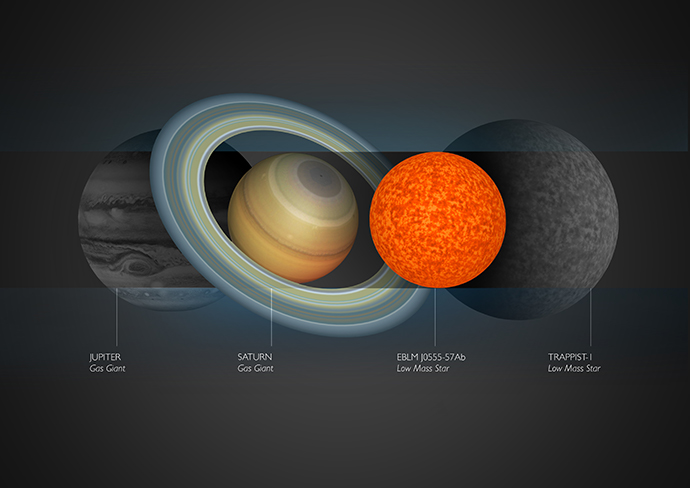Keele helps University of Cambridge find smallest-ever star

Stars like our Sun are much bigger than planets. But now a star has been found that is only the size of the planet Saturn. The star is the smallest ever found that is still able to sustain nuclear fusion in its core, and so still qualify as a star. The tiny star was found by a team from the University of Cambridge, analysing data from the WASP-South survey. The WASP-South camera array, which is operated by Keele University, is designed to look for extra-solar planets, and that meant that it also found the planet-sized star.
What makes this star, known by the catalogue number EBLM J0555-57Ab, of particular interest, is that, despite its diminutive size, it is just massive enough to be able to fuse hydrogen into helium in its core. This is the same process that powers the Sun’s luminosity, and that scientists are attempting to replicate as a powerful energy source here on Earth.
Alexander Boetticher, the lead author of the study, and an MPhil student at the University of Cambridge, was delighted by the discovery: “Had EBLM J0555-57Ab formed with only a slightly lower mass, the fusion reaction of hydrogen in its core could not be sustained, and the star would instead have transformed into a brown dwarf. Our discovery reveals how small stars can be!”
EBLM J0555-57Ab was first noticed when it passed in front of another, larger star that it is orbiting around. This produced an eclipse, a dimming of the visible light, once every orbit. The shallow size of the dip showed that the eclipsing body was only as large as a planet. But when the mass was measured, by the Doppler wobble method using the CORALIE spectrograph built by the University of Geneva, it was found that it was much too massive to be a planet and was instead a star just heavy enough to produce its own energy by nuclear fusion.
Alexander von Boetticher explains: “This star is smaller, and likely colder than many of the heated gas-giant exoplanets that have been identified. Whilst a fascinating feature of stellar physics, it is often harder to measure the size of such dim low-mass stars than for many of the larger planets. Thankfully, we can find these small stars with planet-hunting equipment, when they orbit a larger host star in a binary system.” Sam Gill, a PhD student at Keele University continues: “It might sound incredible, but finding a star can at times be harder than finding a planet!”
EBLM J0555-57Ab has a mass comparable to that of TRAPPIST-1, an ultracool dwarf surrounded by seven temperate Earth-sized worlds, but has a radius that is nearly 30% smaller. “This star was not found serendipitously.“ explains Amaury Triaud, senior researcher at Cambridge’s Institute of Astronomy. “EBLM J0555-57Ab was found as part of a dedicated observing campaign.” The EBLM project aims to measure the mass and size of the smallest stars that exist. Amaury Triaud continues: “The smallest stars provide optimal conditions for the discovery of Earth-like planets, and for the remote exploration of their atmospheres. However, before we can study planets, we absolutely need to understand their stars; this is fundamental.”
All the crucial planetary parameters, like radius and mass, are entirely dependent on the radii and masses that are assumed for their host stars. Despite being the most numerous stars in the Universe, stars with such low masses are poorly known. The EBLM project aims to plug that lapse in knowledge. Didier Queloz, professor at the Cavendish Laboratory concurs: “Thanks to the EBLM project, we will achieve a far greater understanding of the planets orbiting the most common stars that exist, planets like those orbiting TRAPPIST-1.”
Numerous projects like the pale red dot search, as well as the MEarth, TRAPPIST/SPECULOOS/SAINT-EX, Apache and ExTra experiments, are attempting to discover Earth-like planets orbiting small red dwarf stars. “The EBLM project is essential in supporting these multiple international efforts,” concludes Stéphane Udry, director at the Department of Astronomy, at the University of Geneva.
The discovery has been accepted for publication as a Letter to the journal Astronomy & Astrophysics. A pdf version can be accessed at https://arxiv.org/abs/1706.08781
This research is lead by researchers of the Centre for Exoplanet Research at the University of Cambridge. Contributing to this work are researchers from Keele University, the University of Geneva, the Austrian Academy of Sciences, the Max Planck Institute for Astronomy, the University of St Andrews, the University of Warwick, the University of Liège, the Autonomous National University of Mexico, and the Hobat and William Smith Colleges.

Image credits: IoA/Amanda Smith
Image caption: [illustration] The sizes of Saturn and EBLM J0555-57Ab are compared to one another. In the shadows, Jupiter and TRAPPIST-1 are represented to scale. One version of this illustration contains no text. Another version contains labels for each of the objects, and the third version contains the parameters of the planets and that stars that are depicted, using units based on the measurement of Jupiter and the Sun.


